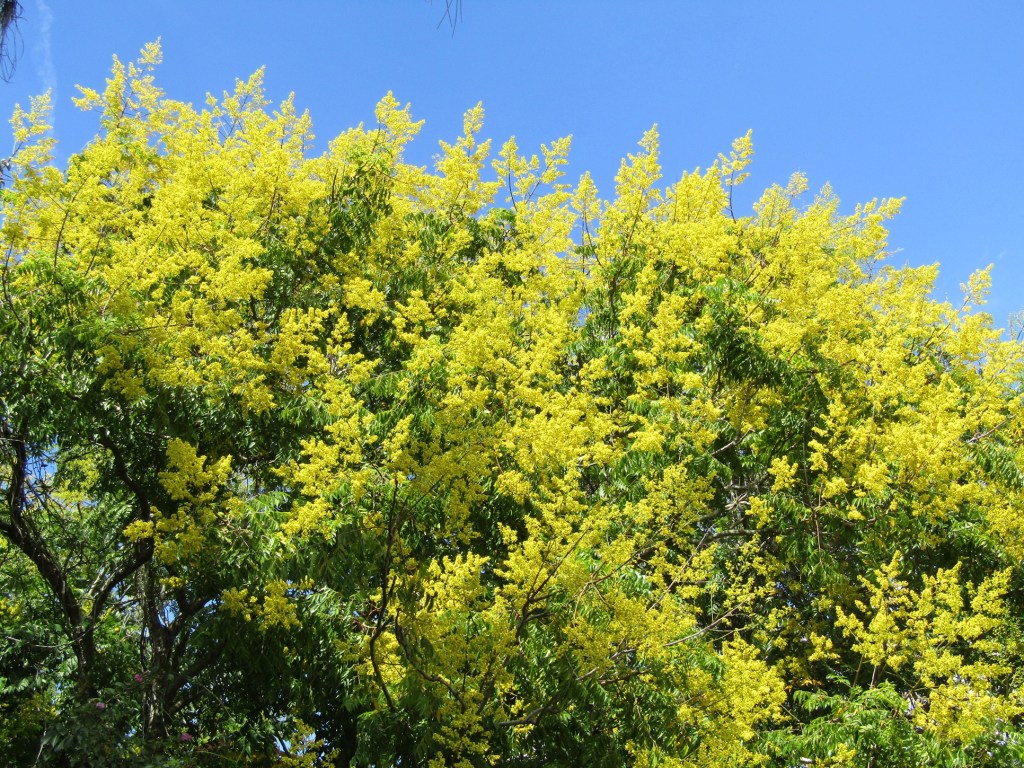Question: We recently noticed that there are a lot of trees in our older area that have yellow flowers. What are they and where can I get them?
Answer: You found a golden rain tree with large spikes of yellow flowers followed by pink seed pods. Unfortunately, no matter how attractive the tree is, it is not recommended to plant it in new areas, as it is very prolific. These are listed as Category II invasive plants by the Florida Exotic Pest Plant Council. I doubt you can find them at your local garden center. Golden rain trees in older areas probably started from seeds distributed by wild animals and continue to spread in these locations. Trees have an advantage in that they survive in a variety of soil conditions. However, there is also a pest called the Jadera or Golden Rain Tree Bug. It is a red and black insect that feeds on the seeds of the golden rain tree. So while they may be beneficial, they are a nuisance. This means that if you don’t plant your Golden Rain Tree, you won’t have insects or lots of seedlings that need to be removed.
Q. My Gold Mound Duranta hedge was heavily pruned by the gardener. Will it go back to normal if I water and fertilize it?
A. Hedges usually don’t need severe pruning and can produce new growth to fill gaps. Granted, the email photo you sent showed a skeletonized duranta hedge full of twig buds, but it looks a little run down. However, there may be a lot of yellowish leaves among the twigs. If the twigs are green when rubbed, you can expect new growth to begin within a few weeks. This type of renewal pruning is not uncommon in hedges. Moisten the soil and fertilize it, and you’ll be back to the plant you remember.
Q. I am enjoying the brightly colored caladiums I got from the garden center. At this time of year, the leaves are decreasing and they appear to be withered. Is this normal?
A. Gardeners will enjoy great color for about eight months before caladiums begin to fade and go into a resting period. The later the tubers, often called bulbs, start growing in spring or early summer, the longer the leaves will last from fall to early winter. Give the plant normal care and wait for it to gradually decline. Once the leaves turn from yellow to brown, you can prune them from the plant. Plants in containers or in the ground should be kept slightly dry during their resting period, which lasts from late winter until the warm days of spring.
Q. I grow azaleas, but I haven’t fertilized them since spring. Is there still time to apply the product to feed?
Plant Doctor: Tips for maximizing your chrysanthemum blooms
A. Fall is a good time to fertilize all ornamental plants. If you know the soil acidity of your planting site and it’s acidic enough for your azaleas, a general landscape fertilizer will suffice. If you do not know the acidity or if it is more than neutral, please use azalea-based fertilizer. This provides additional micronutrients and helps create suitable soil conditions for azaleas.
Q. My cucumbers are blooming a lot, but they haven’t set fruit yet. Since the plant is potted, does it need to be moved to a better location to attract pollinators?
A. You can post signs and do bee dances to attract pollinators, or you can wait a little longer. Often, the first flowers on cucumbers, pumpkins, and melons are male flowers and have no potential for fruiting. But after a while, female flowers begin to appear with small immature fruits behind them. That way, bees and other pollinators can do their work. If your plant is in some shade, move it to full sun. You can also find other flowers near your plant that attract pollinators and let them know it’s a place to visit.
Q. My poinsettia was growing steadily and green, but suddenly one side of the plant withered. Is it time to prune your plants?
A. As poinsettias grow during the summer, they can suffer from a variety of problems, the worst of which is mold. If one side of the plant is declining, it may be due to mechanical damage such as wind, but it is more likely that the fungus is affecting one or more stems. The poinsettia pruning period is over except for the dead parts. Prune the affected stems so the rest of the plant remains attractive for the holidays. You can also apply a fungicide according to label instructions.

Q. Something is eating the corn and pumpkin seedlings in my garden. Many parts of the leaf have been chewed, but no living creatures are found. What should I do?
A. If you look a little closer, you might find an immature stage of the moth called a fall armyworm inside the corn stalk inside the rolled-up pumpkin leaf. These larvae feed on the leaves of garden crops at night and hide during the day. If there are only a few, you can also pick them from the plant and destroy them as a control. You may also notice wasps flying in to collect larvae to fill their nests. Fortunately, if the larvae numbers are too large to hand-pick, or they are not controlled by wasps, there are some things you can do to control them naturally at your local independent garden center. Choose either a foliar spray insecticide or a spinosad-containing insecticide according to label instructions. Repeat spraying may be necessary if the worms cannot be controlled within a few days. Pay attention to the time between the last application and harvest.
Tom McCubbin is an emeritus urban horticulturist for the University of Florida Cooperative Extension Service. Write to Orlando Sentinel, PO Box 2833, Orlando, FL 32802. Email: TomMac1996@aol.com.
Botanist: It’s never too late to plant sunflowers in your garden

